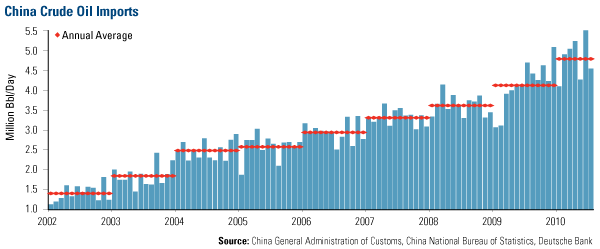All indications are that China will see a GDP growth slowdown through the end of 2010 as the Beijing government works to take some of the heat out of property prices in the country’s key cities.
We see this short-term slowdown as a good thing in the longer term because, by acting before there’s an economy-wrecking crisis, China can position itself for a more sustainable growth pace going forward. This means a lesser reliance on exports and fixed-asset investment, and more emphasis on the domestic sector.
 This chart from Deutsche Bank, which appeared in U.S. Global’s weekly Investor Alert, shows the progression of China’s crude oil imports going back to 2002.
This chart from Deutsche Bank, which appeared in U.S. Global’s weekly Investor Alert, shows the progression of China’s crude oil imports going back to 2002.
As you can see, the trend—represented by the red annual average lines—shows that China is importing three times more crude than eight years ago to support its economic growth.
Last month’s imports (the farthest right vertical blue line) show a steep fall off from June’s levels, and PetroChina forecasts slow growth through year-end as industrial production and GDP growth fall off.
But in 2011, Deutsche Bank’s analysts say, the story gets better. Refining capacity is scheduled to expand beginning in September, and these refineries will need more imported crude to operate.
The International Energy Agency (IEA) predicted last week that China will use more than 9.3 million barrels per day in 2011, up 4.5 percent from this year. The IEA says China will account for one-third of new crude oil demand next year.
Another driver for imports: China is building its strategic petroleum reserve and will add 40 million barrels worth of storage capacity in the first half of 2011.
Read how China factors into our Case for Natural Resources.
The following securities mentioned in the article were held by one or more of U.S. Global Investors family of funds as of 6/30/10: PetroChina